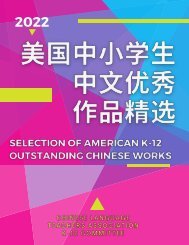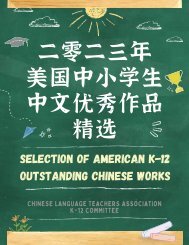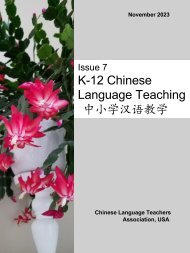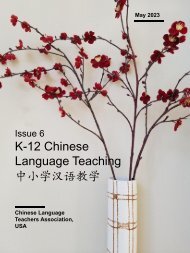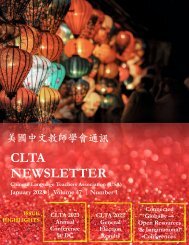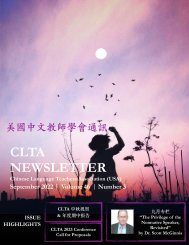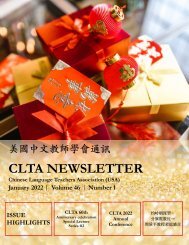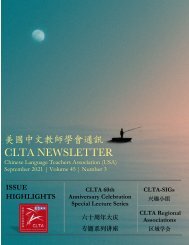CLTA newsletter May 2019
You also want an ePaper? Increase the reach of your titles
YUMPU automatically turns print PDFs into web optimized ePapers that Google loves.
<strong>CLTA</strong> NEWSLETTER<br />
Current Studies<br />
Nin EChinese W B OLanguage O K I Nand F ODiscourse<br />
R M AT I O N<br />
Discourse studies / Pragmatics / Sino-Tibetan languages<br />
Cu rren t St u d ies in Ch in ese Lan gu age an d<br />
Discou rse<br />
Global context and diverse perspectives<br />
Bryan t U n iversit y / Th e U n iversit y of Syd n ey<br />
Th is volu m e feat u res a d iscou rse em p irical orien t at ion from d iverse p ersp ect ives an d<br />
variou s m et h od ologies, in w h ich n arrat ives, in t erview s, su rveys, an d large -scale d at ab ases<br />
or self-creat ed w rit t en an d sp ok en corp ora are em p loyed an d an alyz ed t o gain a b et t er<br />
u n d erst an d in g of n ew d evelop m en t s an d ch an ges in Ch in ese lan gu age an d d iscou rse.<br />
Au t h ors em p loy u p d at ed ap p roac h es from a variet y of fi eld s, in clu d in g ap p lied lin gu ist ics ,<br />
fu n ct ion al lin gu ist ics , corp u s lin gu ist ics an d sociolin gu ist ics , t o d escrib e t h e st ru ct u re<br />
of Ch in ese lan gu age an d d iscou rse an d t o ex am in e it s crit ical issu es , m an y focu sin g on<br />
glob aliz at ion -in d u ced lan gu age d evelop m en t s an d c h an ges. Wit h an em p irically-b ased<br />
d iscou rse/socio -cu lt u ral ap p roach, t h is collect ion m ak es v alu ab le con t rib u t ion s t o researc h<br />
on Ch in ese lan gu age an d d iscou rse an d serves as a sou n d referen ce for Ch in ese researc h ers<br />
an d ed u cat ors in d iverse fi eld s su c h as Ch in ese lan gu age an d d iscou rse, Ch in ese lin gu ist ics<br />
an d lan gu age ed u cat ion , Ch in ese m u lt icu lt u ralism , an d m ore.<br />
Table of contents<br />
Contributors<br />
Chapter 1. Chinese discourse from diverse<br />
perspectives: An introduction<br />
Yun Xiao and Linda Tsung<br />
Chapter 2. New words in contemporary<br />
Chinese language use: Linguistic<br />
features and formation processes<br />
Yun Xiao<br />
Chapter 3. Usage based language change and exemplar<br />
representations in Beijing Mandarin Chinese<br />
Liang Tao<br />
Chapter 4. Contextual variations of internal<br />
and external modifications in Chinese<br />
requests: c Effets of power and imposition<br />
Shuai Li<br />
Chapter 5. Some interactional functions of Yinweiclauses<br />
in Mandarin Chinese conversation<br />
Xiaoting Li and Jie Luo<br />
Chapter 6. Preliminaries to delicate matters:<br />
Some functions of “I say to you” sequences<br />
in Mandarin Chinese conversations<br />
Ni-Eng Lim<br />
Chapter 7. Chinese near-synonyms jian<br />
( 建 ), zao ( 造 ), gai ( 蓋 ) ‘to build’ revisited<br />
Chenhsuan Huang<br />
Chapter 8. Constraints on the collocational behaviors<br />
of Chinese near-synonyms: A corpus-based analysis<br />
Jia Yang<br />
Chapter 9. Genericity and sentences with an<br />
AP state complement in Mandarin Chinese<br />
Fei Ren<br />
Chapter 10. Kinship metaphors in the<br />
Chinese construction A shi B zhi fu/mu:<br />
Biology and culture as conceptual basis<br />
Lin Zhu<br />
Chapter 11. a The classifict ion of<br />
Chinese time expressions from Systemic<br />
Functional Linguistics Perspectives<br />
Linda Tsung and Lubei Zhang<br />
Chapter 12. Being a Kam in China:<br />
Ethnic identity in narratives<br />
Wei Wang, Lisong Jiang and Meishu He<br />
Chapter 13. Specialised corpora for Chinese<br />
language education in Singapore<br />
Hock Huan Goh, Jinzhan Lin and Chunsheng Zhao<br />
Index<br />
JO H N B E N JA M I N S P U B LI S H I N G C O M P A N Y<br />
www.benjam ins.com<br />
31





